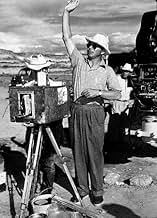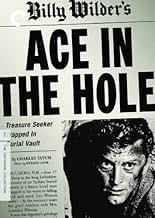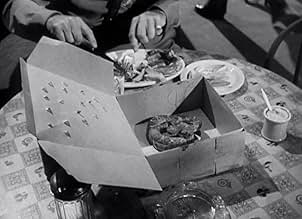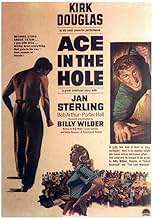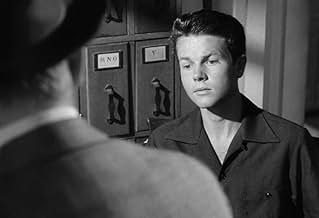CALIFICACIÓN DE IMDb
8.1/10
41 k
TU CALIFICACIÓN
Un ex-periodista frustrado atrapado trabajando para un periódico de Albuquerque explota una historia sobre un hombre atrapado en una cueva para reavivar su carrera, pero la situación rápidam... Leer todoUn ex-periodista frustrado atrapado trabajando para un periódico de Albuquerque explota una historia sobre un hombre atrapado en una cueva para reavivar su carrera, pero la situación rápidamente se convierte en un circo fuera de control.Un ex-periodista frustrado atrapado trabajando para un periódico de Albuquerque explota una historia sobre un hombre atrapado en una cueva para reavivar su carrera, pero la situación rápidamente se convierte en un circo fuera de control.
- Dirección
- Guionistas
- Elenco
- Nominado a 1 premio Óscar
- 5 premios ganados y 3 nominaciones en total
Robert Arthur
- Herbie Cook
- (as Bob Arthur)
Roy Regnier
- Nagel - New York Editor (replaced by Richard Gaines)
- (escenas eliminadas)
Oscar Belinda
- Barker
- (sin créditos)
Opiniones destacadas
A powerful toasting of the media of the day. Imagine what this would have been like in the age of television. Kirk Douglas plays a self-centered heel, and does so very well. I also liked Jan Sterling as Lorraine. It's true that there is no really sympathetic character in this film, except maybe Leo, the man trapped in the cave. Someone wrote that he too, wasn't a sympathetic character, because he was trapped while collecting Indian artifacts for sale, but I don't think that would have bothered anyone in 1951. The tone of the film throughout was one of total cynicism, that seems a bit out of place for the times. Maybe that's why this movie was not a commercial success. It fits much better now, though, since everyone has seen the media behaving in such disgraceful fashion. However, that may rob it of some of its (probably intended) shock value. Grade: A
Billy Wilder's first commercial failure, but one of his best films, almost up there with "Sunset Blvd." Ambitious reporter Chuck Tatum (Kirk Douglas) finds out a man is trapped in a collapsed mine. By spewing out bogus engineering, he manages the rescue of the poor man to become more complicated, and time consuming then needed. Meanwhile, it becomes an amazing news item, something that makes Tatum the best known reporter in the country. However, everybody's luck runs out at the end. Perhaps the cause of failure of this film is that there are no sympathetic characters here. Douglas plays a total creep, the trapped man's wife is a floozy "I'm not going to pray for him! Praying ruins my nylons!" in the film. Even the trapped man is somebody who was poking around Indian graves. The screenplay, and the lead performances are top class. The extensive location photography, and somewhat documentary look of the film makes the film feel more modern than most 1951 films. Billy Wilder calls this film "the runt of his litter" Don't be so harsh, Billy, it's an excellent picture!
10zinkster
One of Billy Wilder's great movies, with a superb acting job by Kirk Douglas as the cynical, glory-seeking and even desperate reporter whose only goal is get back in the limelight by regaining his former big-city news desk job.
The idea of such a newspaper reporter manipulating events to stretch out a story at the expense of and disregard for the victim still seems nearly inhuman, but Douglas' performance makes it instantly believable. The story scenario in which locals, then passers-by and finally distant tourists gravitate to and then make a festival or circus out of the event (the film was also released under the title "The Big Carnival") is supported by the real events on which the story was most likely based: the West VA mine disaster in 1925 that trapped miner Floyd Collins and was reported for 17 days, much as in the film, by local newspaperman Skeets Miller, who crawled into the mineshaft for face-to-face interviews with the trapped and doomed Collins.
This movie fits nicely into the Film Noir genre, although it takes place largely under the hot, harsh glare of the Arizona sun, highlighting the sweat and grime visible on the characters' skin and creating a visual metaphor for the sorry state of their souls. I wonder if Henri-Georges Clouzot saw this film before he began filming "The Wages of Fear," because the visually pervasive atmosphere of sweat and filth and opportunism are equally present in both.
The idea of such a newspaper reporter manipulating events to stretch out a story at the expense of and disregard for the victim still seems nearly inhuman, but Douglas' performance makes it instantly believable. The story scenario in which locals, then passers-by and finally distant tourists gravitate to and then make a festival or circus out of the event (the film was also released under the title "The Big Carnival") is supported by the real events on which the story was most likely based: the West VA mine disaster in 1925 that trapped miner Floyd Collins and was reported for 17 days, much as in the film, by local newspaperman Skeets Miller, who crawled into the mineshaft for face-to-face interviews with the trapped and doomed Collins.
This movie fits nicely into the Film Noir genre, although it takes place largely under the hot, harsh glare of the Arizona sun, highlighting the sweat and grime visible on the characters' skin and creating a visual metaphor for the sorry state of their souls. I wonder if Henri-Georges Clouzot saw this film before he began filming "The Wages of Fear," because the visually pervasive atmosphere of sweat and filth and opportunism are equally present in both.
Saw this films years ago and it's still gripping.Mr.Wilder seldom did films that gripped the human condition like this one.After this movie flopped he stuck to screen adaptions of stage hits through most of the fifties.Both director and star,Kirk Douglas really delivered a stinging expose of media hype and manipulation of the newspaper business.Herein,burned out reporter Douglas chances on a man trapped in a cave and ruthlessly exploits it for his own gain.There's no softness here,even the leading lady (played wonderfully by Jan Sterling)is as hard as Douglas.The scenes of all the gawkers showing up,complete with carnival,are outright creepy.There's even a cheesy country western singer plunking a guitar and singing about poor Leo,(the trapped man.) The only sympathetic person is poor Leo's mom who continually prays for his release.Definitely a film for lovers of great movie drama.
Of the many movies I viewed in the early 50's, so many ,like now, were here today, forgotten tomorrow. However some movies that became memorable and that were able to make a dramatic impact on this young guy include, Duel in the Sun and Gone with the Wind. Strangely enough, Ace in the Hole is the most memorable of all movies viewed. It is one that invades the mind and leaves one sad.
Few films I remember as vividly as this dark movie, the images linger to haunt me still. 'Why?' one might ask 'would a sombre movie like this made over 50 years ago remain so memorable, when so many others have vanished. Was it the surreal inhumanity of the plot, the repugnant newsman devoid of ethics, the exploitation of the trapped victim, the purposeful prolonging of the victim's entrapment to create a media frenzy, the ultimate commercial creation of an 'event' style attraction complete with a circus like atmosphere surrounding the cave while the victim remained entrapped and close to death.'
Supposedly based on a real incident, it's a tough movie to watch and more so if one is prepared to accept the premise that such inhumanity displayed in the movie has an element of truth.
I echo the desires of others to have the availability of this movie on VHS or DVD. In the interim my memory will continue to keep the images intact. See it if you can.
Few films I remember as vividly as this dark movie, the images linger to haunt me still. 'Why?' one might ask 'would a sombre movie like this made over 50 years ago remain so memorable, when so many others have vanished. Was it the surreal inhumanity of the plot, the repugnant newsman devoid of ethics, the exploitation of the trapped victim, the purposeful prolonging of the victim's entrapment to create a media frenzy, the ultimate commercial creation of an 'event' style attraction complete with a circus like atmosphere surrounding the cave while the victim remained entrapped and close to death.'
Supposedly based on a real incident, it's a tough movie to watch and more so if one is prepared to accept the premise that such inhumanity displayed in the movie has an element of truth.
I echo the desires of others to have the availability of this movie on VHS or DVD. In the interim my memory will continue to keep the images intact. See it if you can.
¿Sabías que…?
- TriviaAfter the film was released, it got bad reviews and lost money. The studio, without Billy Wilder's permission, changed the title to "The Big Carnival" to increase the box office take of the film. It didn't work. On top of that, Wilder's next picture, Infierno en la tierra (1953), was a hit and he expected a share of the picture's profits. Paramount's accountants told him that since this picture lost money, the money it lost would be subtracted from the profits of "Stalag 17".
- ErroresWhen Lorraine and Chuck are talking out in front of Minosa's store by the gas pumps, reflections of the crew moving around behind the camera can be seen in the store windows.
- Citas
Charles Tatum: Bad news sells best. Cause good news is no news.
- ConexionesFeatured in AFI Life Achievement Award: A Tribute to Billy Wilder (1986)
- Bandas sonorasThe Hut-Sut Song
(uncredited)
Written by Leo Killion, Ted McMichael and Jack Owens
Sung by Richard Benedict and Kirk Douglas
Selecciones populares
Inicia sesión para calificar y agrega a la lista de videos para obtener recomendaciones personalizadas
Detalles
Taquilla
- Presupuesto
- USD 1,800,000 (estimado)
- Total a nivel mundial
- USD 2,300,087
- Tiempo de ejecución
- 1h 51min(111 min)
- Color
- Relación de aspecto
- 1.37 : 1
Contribuir a esta página
Sugiere una edición o agrega el contenido que falta


